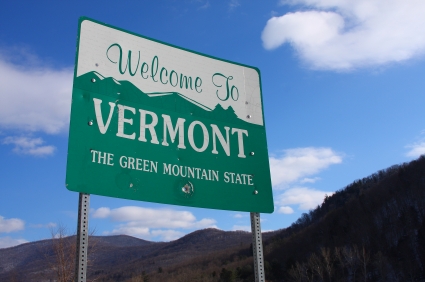Vermont’s feed-in tariff legislation became law at the end of business on May 27, 2009.
H. 446 is the first legislation calling for a full system of advanced renewable tariffs in the US to pass the legislature and become law. The bill includes changes to Vermont’s Sustainably Priced Energy Enterprise Development Program (SPEED) that would implement a pilot feed-in tariff policy.
Vermont’s action follows closely on that of the Ontario provincial legislature’s groundbreaking Green Energy Act and with several states considering similar legislation, the Green Mountain state could be the tipping point for a rapid succession of feed-in tariff policies across the continent.
It may be small states, such as Vermont, and municipalities, such as Gainesville, Florida, that could drive new renewable energy policy in the US and not the big states of California or Florida that are hopelessly embroiled in partisan stalemates.
Unlike the policy in Washington State and in the crude feed-in tariff in California, Vermont’s legislation bases the tariffs on the cost of generation plus a reasonable profit. Costs of the program in Vermont are borne by ratepayers, not taxpayers as in the Washington State system.
One unique feature in the Vermont program not found in Ontario is a specific tariff for small wind turbines, those less than 15 kW. Though several bills have contained proposed tariffs for small wind turbines, Vermont’s legislation is the first to become law with long term contracts. The tariff of $0.20/kWh is the highest in North America.
Though it has a low program cap of only 50 MW, Vermont’s feed-in tariff policy is a serious commitment by a state of its size. Vermont has a population of little more than 600,000.
Vermont’s feed-in tariff program contains the key elements of the successful policies found in Europe:
- Tariffs are differentiated by technology
- Tariffs are differentiated by size.
- Tariffs set on the cost of generation plus profit
- Profit set by a reasonable rate of return
- Long contracts terms
- Regular program review
As the technology progresses, Vermont renewable energy advocates expect the tariffs will decrease. The bill directs the Vermont Public Service Board to review and reset the tariffs every two years. The first review begins September 15, 2009 when the PSC will open a case on the tariffs contained in the legislation.
Renewable Energy Vermont (REV) led the successful grassroots’ campaign, the first of its kind in New England to focus on feed-in tariffs. REVs Executive Director, Andrew Perchlik, notes that “This law puts Vermont in a leadership role on renewable energy policy and will help to bring vibrant growth and development to our local renewable energy industry.”
Here are several key elements of H. 446:
- Program cap of 50 MW
- Project size cap of 2.2 MW
- Contract term: 20 years
- Wind energy tariffs
- <15 kW: $0.20/kWh
- >15 kW: $0.14/kWh
- Landfill and biogas tariff of $0.12/kWh
- Solar tariff of $0.30/kWh
- Future tariffs based on cost of generation plus profit less applicable tax credits and other incentives
- Profit set at rate of return of Vermont electric utilities
- Open a regulatory examination of the tariffs by September 15, 2009 and new rates set in January, 2010
Under Vermont law the Governor had the choice to sign the legislation into law, veto the bill, or to let it become law without his signature. He chose the latter course to the joy of long-suffering renewable energy advocates in Vermont.
In a statement, Republican Governor James Douglas said, “Even though this bill does set statutory standard offer rates, which I believe is inappropriate, because the Public Service Board must revisit those rates within the next four months and periodically thereafter, I will allow this bill to become law without my signature.”
The effort now shifts to the Public Service Board to ensure that the hard won progress on tariff setting is not lost in the regulatory fog.



